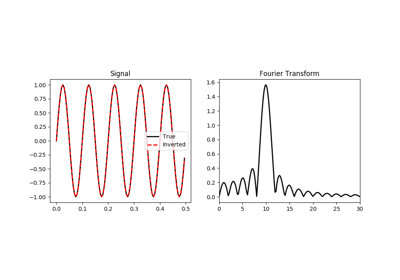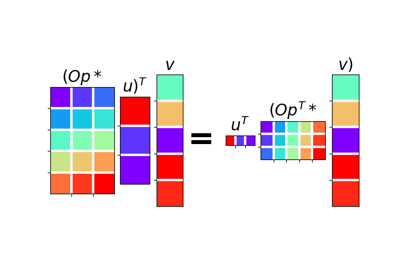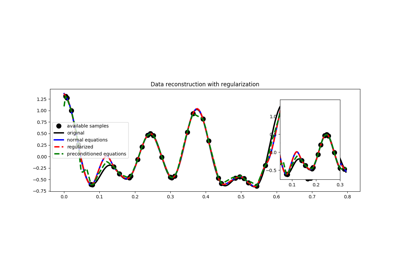pylops.signalprocessing.FFT¶
-
pylops.signalprocessing.FFT(dims, dir=0, nfft=None, sampling=1.0, real=False, fftshift=False, engine='numpy', dtype='complex128', **kwargs_fftw)[source]¶ One dimensional Fast-Fourier Transform.
Apply Fast-Fourier Transform (FFT) along a specific direction
dirof a multi-dimensional array of sizedim.Note that the FFT operator is an overload to either the numpy
numpy.fft.fft(ornumpy.fft.rfftfor real models) in forward mode and to the numpynumpy.fft.ifft(ornumpy.fft.irfftfor real models) in adjoint mode, or to thepyfftw.FFTWclass.In both cases, scaling is properly taken into account to guarantee that the operator is passing the dot-test.
Note
For a real valued input signal, it is possible to store the values of the Fourier transform at positive frequencies only as values at negative frequencies are simply their complex conjugates. However as the operation of removing the negative part of the frequency axis in forward mode and adding the complex conjugates in adjoint mode is nonlinear, the Linear Operator FTT with
real=Trueis not expected to pass the dot-test. It is thus only advised to use this flag when a forward and adjoint FFT is used in the same chained operator (e.g.,FFT.H*Op*FFT) such as inpylops.waveeqprocessing.mdd.MDC.Parameters: - dims :
tuple Number of samples for each dimension
- dir :
int, optional Direction along which FFT is applied.
- nfft :
int, optional Number of samples in Fourier Transform (same as input if
nfft=None)- sampling :
float, optional Sampling step
dt.- real :
bool, optional Model to which fft is applied has real numbers (
True) or not (False). Used to enforce that the output of adjoint of a real model is real.- fftshift :
bool, optional Apply fftshift/ifftshift (
True) or not (False)- engine :
str, optional Engine used for fft computation (
numpyorfftw)- dtype :
str, optional Type of elements in input array.
- **kwargs_fftw
Arbitrary keyword arguments for
pyfftw.FTTW
Raises: - ValueError
If
dimsis not provided and ifdiris bigger thanlen(dims)- NotImplementedError
If
engineis neithernumpynornumba
Notes
The FFT operator applies the forward Fourier transform to a signal \(d(t)\) in forward mode:
\[D(f) = \mathscr{F} (d) = \int d(t) e^{-j2\pi ft} dt\]Similarly, the inverse Fourier transform is applied to the Fourier spectrum \(D(f)\) in adjoint mode:
\[d(t) = \mathscr{F}^{-1} (D) = \int D(f) e^{j2\pi ft} df\]Both operators are effectively discretized and solved by a fast iterative algorithm known as Fast Fourier Transform.
Note that the FFT operator is a special operator in that the adjoint is also the inverse of the forward mode. Moreover, in case of real signal in time domain, the Fourier transform in Hermitian.
Attributes: - dims :


